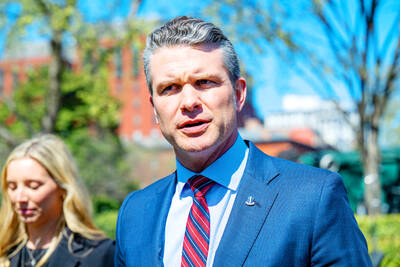Former president Lee Teng-hui (李登輝) yesterday departed for Japan on a one-week private visit, his sixth such trip in 14 years.
Lee said prior to his departure that he would use the opportunity to discuss with Japanese experts issues related to cancer treatment, solar photovoltaic energy and livestock breeding.
Accompanied by his wife, Tseng Wen-hui (曾文惠), and their two daughters, Anna Lee (李安娜) and Annie Lee (李安妮), the 91-year-old landed at Osaka airport.

Photo: Chu Pei-hsiung, Taipei Times
According to the Friends of Lee Teng-hui Association, which helped organize the trip, Lee will deliver a speech in Osaka today, before traveling to Tokyo on Sunday, where he is scheduled to give another speech and tour renewable energy facilities.
His last stop is in Hokkaido on Tuesday, where Lee is scheduled to visit livestock breeding and dairy businesses, the association said.
Lee, the nation’s first democratically elected president and an outspoken supporter of Taiwanese independence, last visited Japan in September 2009.
The current tour is Lee’s sixth visit to Japan since May 2000, when he retired after having been in office for 12 years.
The first Taiwan-born president, Lee spent 22 years under Japanese rule — from when he was born in 1923 until the period ended in 1945 — and has expressed affection for the nation’s former colonial ruler.

A magnitude 4.9 earthquake struck off Tainan at 11:47am today, the Central Weather Administration (CWA) said. The hypocenter was 32.3km northeast of Tainan City Hall at a depth of 7.3km, CWA data showed. The intensity of the quake, which gauges the actual effect of a seismic event, measured 4 in Tainan and Chiayi County on Taiwan's seven-tier intensity scale, the data showed. The quake had an intensity of 3 in Chiayi City and County, and Yunlin County, while it was measured as 2 in Kaohsiung, Nantou County, Changhua County, Taitung County and offshore Penghu County, the data showed. There were no immediate reports of

‘DENIAL DEFENSE’: The US would increase its military presence with uncrewed ships, and submarines, while boosting defense in the Indo-Pacific, a Pete Hegseth memo said The US is reorienting its military strategy to focus primarily on deterring a potential Chinese invasion of Taiwan, a memo signed by US Secretary of Defense Pete Hegseth showed. The memo also called on Taiwan to increase its defense spending. The document, known as the “Interim National Defense Strategic Guidance,” was distributed this month and detailed the national defense plans of US President Donald Trump’s administration, an article in the Washington Post said on Saturday. It outlines how the US can prepare for a potential war with China and defend itself from threats in the “near abroad,” including Greenland and the Panama

The Chinese Nationalist Party (KMT) is maintaining close ties with Beijing, the Democratic Progressive Party (DPP) said yesterday, hours after a new round of Chinese military drills in the Taiwan Strait began. Political parties in a democracy have a responsibility to be loyal to the nation and defend its sovereignty, DPP spokesman Justin Wu (吳崢) told a news conference in Taipei. His comments came hours after Beijing announced via Chinese state media that the Chinese People’s Liberation Army’s Eastern Theater Command was holding large-scale drills simulating a multi-pronged attack on Taiwan. Contrary to the KMT’s claims that it is staunchly anti-communist, KMT Deputy

RESPONSE: The government would investigate incidents of Taiwanese entertainers in China promoting CCP propaganda online in contravention of the law, the source said Taiwanese entertainers living in China who are found to have contravened cross-strait regulations or collaborated with the Chinese Communist Party (CCP) could be subject to fines, a source said on Sunday. Several Taiwanese entertainers have posted on the social media platform Sina Weibo saying that Taiwan “must be returned” to China, and sharing news articles from Chinese state media. In response, the Mainland Affairs Council (MAC) has asked the Ministry of Culture to investigate whether the entertainers had contravened any laws, and asked for them to be questioned upon their return to Taiwan, an official familiar with the matter said. To curb repeated